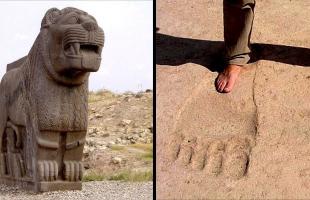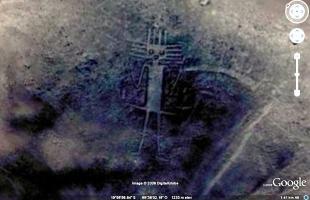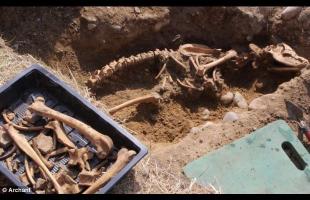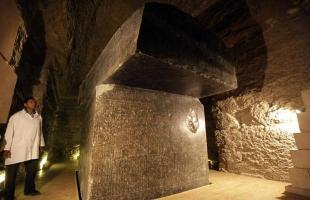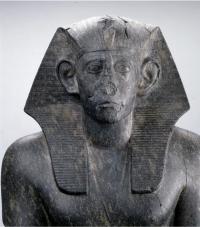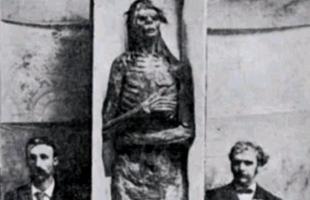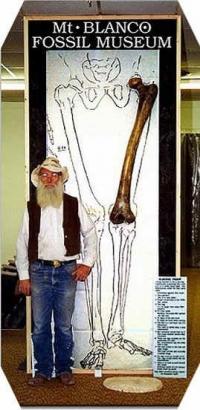Ailuropoda melanoleuca: the Giant Panda

Scientific Name: Ailuropoda melanoleuca
The scientific name means simply "panda footed black and white creature"
Fossil Record: The fossil record of the giant panda is incomplete. Some intermediate stages have been suggested. A small bear like animal, Agriarctos, that lived in the mid Miocene (about 3 millon years ago) is an ancestor of the giant panda. The fossils of the present day giant panda can be found from the Early Pleistocene. There may have been as many as 4 species of Ailuropoda. Fossils of Ailuropoda microta, one species, was found to have lived in the early Pleistocene. They were about 1/2 the size of present day pandas. Fossils of Ailuropoda melanoleuca, the present day giant panda, appear in the mid Pleistocene. The distribution of giant pandas was much more extensive in the Pleistocene. Fossils have been found in present day Burma and Vietnam.
In Ancient Chinese History: In the Western Chou dynasty (over 3000 yrs ago), two books : The Book of History and The Book of Songs take note of an animal "Pi" that resembles a panda. Pior pixiu are ancient chinese names for the giant panda. In the Qui dynasty ( 221-207 BC ), the earliest dictonary describes the mo, the giant panda, as a white leopard with a small head, short limbs and black and white markings. It is said to have eaten copper, iron, and bamboo stems. The Annotated Readings of the Book of Songs, refer to an animal zhu yi or bai hu as an animal resembling a white bear. With the many names and different discriptions it becomes hard to tell if the discriptions are of a giant panda or another animal.
In ancient China the giant panda was considered rare and a symbol of might and bravery. The panda has been apart of Chinese culture for over 2000 yrs. When the Empress Dowager Bo (179-163 BC) tomb was opened 2100 yrs after her death, a giant panda skull was found along side her. A historian noted that in the Western Han dynasty(206 BC - 24 AD) the emporor had a garden of rare species, the giant panda was his most treasured animal. The first emporor of the Tang dynasty is said to have once held a banquet where he honored 14 subjects by presenting them with panda skins. His grandson son is said to have sent two live pandas with several pelts to Japan to help seal trade agreements.
Introduction to the Western World:
The giant panda was not known outside of China until a French missionary and naturalist Pere Armand David is brought a dead specimen by hunters on March 23 1869. He writes:
"My Cristian hunters returned today after a ten-day absence. They bring me a white bear, which they took alive but unfortunately killed so that it could be carried more easily, The young white bear, which they sell me very dearly, is all white except for the legs, ears and around the eyes, which are deep black. The colours are the same as those I saw in the skin of an adult bear the other day at the home of Li, the hunter. This must be a new species of "Ursus", very remarkable not only because of its colour, but also for its paws which are hairy underneath, and for other characteristics."
Later in 1869, he describes the panda to Alphonse Milne-Edwards:
"As my collection will not arrive in Paris for some time, I would ask you to Publish quickly the following brief description of a bear which appears to be new to science. Ursus melanoleuca A.D. Very large according to my hunters. Ears short. Hair fairly short; beneath the four feet very hairy. Colours: white, with the ears, the surrounding of the eyes, the tip of the tail and four legs brownish black........The colours are always the same and equally distributed. I have not seen this species, which is easily the prettiest kind of animal I know, in the museums of Europe; perhaps it is new to science!"
In 1870, Alphonse Milne-Edwards received Pere Daivids specimen and upon dissecting it he found that many characterists were unlike that of a bear and more similar to the red panda, Ailurus fulgens. He placed the giant panda in a new genus,Ailuropoda melanoleuca. He later renamed the giant panda Ailuropus (panda-like) seeing a resemblece to the red panda, stating that Ailuropoda was a name already in use. Aeluropus, the latin spelling of Ailuropus was also used in scientific literature to refer to the giant panda. For a period of time these three names Ailuropoda, Ailuropus, and Aeluropus were used in scientific literature. In some places, even the common name "panda" was taken to mean either the giant or red panda.
In 1914, the first westerner to see alive panda was a German zoologist Hugo Weigold.
This set off a string of western hunters seeking a giant panda pelt. Amoung the the first western hunters to kill a giant panda was Kermit and Theodore Roosevelt in 1928. They were the sons of president Theodore Roosevelt. On April 24 1939, China issued an order that prohibited the capture of giant pandas.
Ruth Harkness was the first person to introduce alive panda cub (Su ling) to the western world. Her adventure can be read in her book "The Lady and the Panda." The panda cub was brought tothe Brookfiels Zoo in Chicago in 1936. Pandas became the animal for zoos to aquire. Three other pandas were captured and taken to the U.S in the 1930's, Mei Mei, Pandora, and Pan. Pao Pei was the last panda that was captured and exported by a western nation. By 1945 there were only five giant pandas outside China. In 1953, there were NO giant pandas alive in CAPTIVITY anywhere...even China. In 1957, the panda Ping Ping was sent to the Moscow Zoo as a gift.
Famous ??? Giant Pandas: Besides the first panda the west saw, Su ling there have been many other pandas to win the publics hearts. Such as Chi Chi (Naughty girl)....at the London Zoo in 1958. In 1972 when China was recognized the the U.S., two pandas were a gift to the U.S. Hsing Hsing and Ling Ling (She died in 1992 at age 23) reside at the National Zoo in Washington D.C.. Bai Yun and Shi Shi currently reside at the San Diego Zoo.
Adaptation and Evolution of the Giant Panda
Anatomical Adaptations:The giant panda posses several anatomical adaptations that increase the efficiently of gathering, processing, and sustaining itself on a diet of bamboo. Adaptations of the masticatory apparatus, alimentary tract, and radial sesamoid bone are the most significant changes from a omnivorous bear form to a specialized herbivorous form. This transition was probably only resulted from a few simple genetic changes. The large body size of the giant panda also appears to be an adaptation to the low nutritional value of bamboo.
General Skeleton:
The skeleton of the giant panda is very similar to that of bears except for a general increase of size of the compact bone throughout the entire skeleton. The most advantageous place for the giant panda to have an enlarged skeleton is in the skull region to support the increase in mastication (jaw) musculature. Hypertrophy (increase) of the whole skeleton may have been necessary to increase the size of the skull, thereby allowing a quick, powerful closure of the mandible.
Skull:
The giant panda skull and mandible include modifications that adapt a carnivore skull to an herbivorous diet. The temporal fossa is expanded and provides more extensive muscle attachment for the temporalis muscle. The zygomatic arch is enlarged to provide a larger surface area of attachment for the masseter and zygomaticomandibular muscles. The zygomatic arch also is expanded laterally to increase the temporal fossa. This lateral expansion limits the horizontal movement of the jaw. Having larger muscles allows the giant panda to crush the tough bamboo stalks.
Mandible:The mandible is twice the length of the bear's mandible. The coronoid process provides a larger attachment for the temporal muscle. The mandibular articulation limits the movement of the jaw to a monoaxial plane. The jaw can not move in a horizontal motion that is needed to sufficiently grind plant material.
Dentition:
The giant panda's dentition is modified from that of bears. The Dental formula for (carnivore) bears is 3/3, 1/1, 4/4, 2/3, a total of 42 teeth. The giant panda's dental formula is 3/3, 1/1, 4/4, 2/2, a total of 40 teeth. The giant pandas premolars and molars have become enlarged and very broad compared to bear teeth. The enlarged molars help crush fibrous plant material.
Radial Sesamoid Bone:
The giant panda has an enlarged carpel bone called the radial sesamoid that acts as a thumb. This is the so called pseudo thumb or "sixth digit" of the panda. The radial sesamoid bone functions as the true thumb. It allows the panda to grasp the bamboo stalks. The modified radial sesamoid bone opposes the first and second digits on the forepaw. The radial sesamoid is slightly enlarged in Ursus (bears). All the muscles necessary for the movement of the radial sesamiod bone are in place in Ursus, just a simple hypertrophy of the bone was all that was necessary to provide the musculature for movement. There is no hypertrophy of the radial sesamoid bone in Procyon lotor (raccoon). The red panda,Ailurus fulgens, has a slighty enlarged radial sesamoid bone but it is not enlarged as the giant pandas.
General Muscular System:
In comparing muscles observations can be made within a group of related organisms. A muscle can be responsive to mechanical stresses on it. A muscle may respond to different stresses by changing its relative size, or by positioning itself for a more advantageous lever action. The masticatory musculature, especially the jaw closing muscles, of the giant panda generally is hypertrophied from the bear musculature. The advantage to the hypertrophy of these muscles is more power when closing the jaw. Some of the masticatory musculature are derived from the mandibular arch. Muscle in the morphological unit are enlarged, such as the digastric muscle a jaw opening muscle, as a unit even when it is not advantageous for the muscle to enlarge.
Mastication Musculature:
The musculature that elevates the mandible is greatly enlarged to produce a swift, powerful, closing movement of the jaw. There are three major muscles that closes the jaw. These muscles are the masseter, zygomandibularis, and temporalis. The masseter muscle provides a quick snapping movement. The zygomandibularis has its origin on the internal face of the zygomatic arch . It inserts on the masseter and tendon fibers. The temporalis muscle has its origin is on the large temporal fossa. It inserts on the on the coronoid process of the mandible. The zygomandibularis and temporalis create a slow but powerful closure of the jaw.
Radial Sesamoid Musculature:
The muscles that move the radial sesamoid bone in the giant panda move the thumb in carnivores. In bears, the radial sesamoid bone is slightly enlarged. The musculature that moves the radial sesamoid bone of the panda already had attachments on the bear radial sesamoid bone. The muscle attachments in the panda would probably result when the radial sesamoid bone enlarged.
The three main muscles that move the radial sesamoid bone: the abductor pollicis, abductor brevis, and the opponens pollicis. The abductor pollicis longus inserts on the proximal side of the radial sesamoid bone. InUrsus americanus, (Black Bear) it inserts on metacarpal 1, and on the radial sesamoid. In the panda, the abductor pollicis longus abducts the radial sesamoid bone. M. Abductor pollicis brevis adduct the radial sesamoid.
The opponens pollicis muscle has its origin on the inner face of the radial sesamoid and inserts on the first phalanx. The action is to adduct the radial sesamoid. In Ursus americanus, M. opponens pollicis has its origins on the radial sesamoid bone and a carpel ligament. In Procyon lotor, there is no attachments of these muscles with the radial sesamoid bone.
Alimentary Tract:The alimentary tract is slightly modified to handle a more herbivorous diet. The esophagus has longitudinal folds are "horny" in appearance, down to the beginning of the stomach. This prevents damage from the sharp fibrous bamboo stalks. The stomach has an extremely muscular pylorus region, and has been described as gizzard-like. This feature allows the bamboo to be kneaded and mixed before entering the intestines. The panda still retains the short intestines of the carnivore. The surface area of the colon is greater in the panda than in bears. The solubility of the cellular contents of bamboo is greatest in the colon.
Body Size:
The large body size of the giant panda is an adaptation to the low nutritive quality of bamboo. Large animals with low body surface area to body volume have lower metabolic rates. The food requirements for sustaining metabolism therefore would be lower. This allows the panda survive on a poor nutrient diet. A larger body size would also obtain more resources. The panda has less surface area exposed to the environment, so less heat is released into the environment. This lowers the energy cost to produce heat. The cost of locomotion is lower per unit weight in larger animals. The overall cost however, is high so a larger animal would travel less than a smaller animal. The giant panda expends little energy in travel, social encounters, etc.
Phylogeny: Modern Evidence:
The question that is most asked is: should the giant panda be placed in the Procyonidae family, Ursidae family or should it be placed in its own family Ailuropodidae? The main disagreement is the degree to which the giant panda to the red panda are related to each other. The red panda has been placed in the Procyonidae family based on morphological and behavioral characteristics; the giant panda has been placed in either the Procyonidae or Ursidae families. Several researchers feel that the giant panda and red panda are not similar enough to either family and place them in a family of there own, Ailuropodidae. The giant panda and red panda don't seem to share characteristics that would link them together other than characteristics that involve diet or habitat. Recently molecular studies have such as DNA hybridization, albumin immunological distances, isozyme genetic distance, and karyotype have been used to determine the phylogenetic relationship of the giant panda. The results of these studies indicate that the giant panda are more closely related to the bear line.
Molecular Studies:
Molecular studies were carried to determine how close the giant panda is related to the red panda and what family the giant panda should be placed in. The most recent molecular studies used four independent molecular tests, DNA hybridization, albumin immunological distances, isozyme genetic distance and karyotype, to determine the pandas phylogeny. Ailuropoda melanoleuca (giant panda), Ailurus fulgens (red panda), Ursus americanus (black bear), andProtor lotor(raccon) were the four species studied. The results of these four studies showed that the giant panda was closer related to the bear line than to the raccoon or red panda.
Chromosomes of the giant panda showed homologies (similar to) to bear chromosomes. Giant pandas has 42 metacentric chromosomes; bears usually have 74 acrocentric chromosomes. There is evidence linking the banding patterns of the bears chromosomes to those of the giant panda. The banding patterns are almost the same as the bears in the giant panda. Chromosomes of the giant panda are a pair of bear chromosomes attached together. For example, Chromosome 1 in the giant panda is homologous to chromosomes 2 and 3 of the brown bear. This is a result of chromosomal fusion in an ancestor of the giant panda. There are few chromosomal homologies that the giant panda shares with the red panda or members of the raccoon family.
The "molecular clock" hypothesis was used to base their results on. The molecular clock hypothesis assumes that the genetic material of a species will diverge continuously over time due to random mutations and be passed on to the next generation. Since mutations will compile over time, the amount that two species would differ in their DNA nucleotide sequence should indicate the degree to which the two species are related. The time at which the two species diverge from a common ancestor should be able to be found. The study speculates that the bear and raccoon families diverged about 30-50 million years ago. The ancestor of the giant panda diverged from the bear line about 18-25 million years ago. The study shows that the red pandas ancestor split from the raccoon line shortly after the bear and raccoon divergence.
A second set of molecular studies were run to compare the results of the earlier studies. Protein electrophoresis was used to estimate the genetic distance of eight members of the Ursidae family ( including the giant panda) and two members of the Procyonidae family (including the red panda. Phylogenetic lineages were than constructed using the molecularhypothesis. The results confirmed the previous studies results that the giant panda diverged from the bear line 18-25 million years ago.
Molecular Studies on the Red Panda:The red panda is commonly placed in the raccoon family. The red panda was placed in the Procyonidae family due to similar morphological and behavioral characteristic over a 100 years ago. There is recent anatomical and molecular evidence that suggests that the red panda did not split off from the procyonid line. The phylogeny of the red panda has become unclear over the past few years .
Conclusion:The giant panda is a highly modified carnivore that has adapted to a herbivorous diet. The giant panda has several adaptations that facilitates its herbivorous diet. In order to obtain the necessary nutrition the panda must eat large quantities of bamboo to maintain basic metabolic needs. Anatomical adaptations such as enlarged mastication musculature, an opposing radial sesamiod bone, and modified alimentary tract allow the panda to utilize a low nutrient diet of bamboo. If the panda is to survive on an herbivorous diet it must conserve energy whenever possible. By limiting social interactions, locomotion, mating periods, altricial young, and other factors the giant panda limits energy expenditure. The evolution of the giant panda has been disputed in the scientific community for over 100 years. Anatomical, molecular and fossil record evidence strongly support that the giant panda diverged from the bear line.
Anatomically the giant panda and bear are similar except for a few simple changes of the omnivorous bear to the herbivorous panda. Molecular evidence dates the divergence of the giant panda from the bear line about 18-25 million years ago. The red panda was once thought to be closely related to the giant panda. The red panda seems to only to share similar characteristics with the giant panda that are used in its similar diet and habitat.










